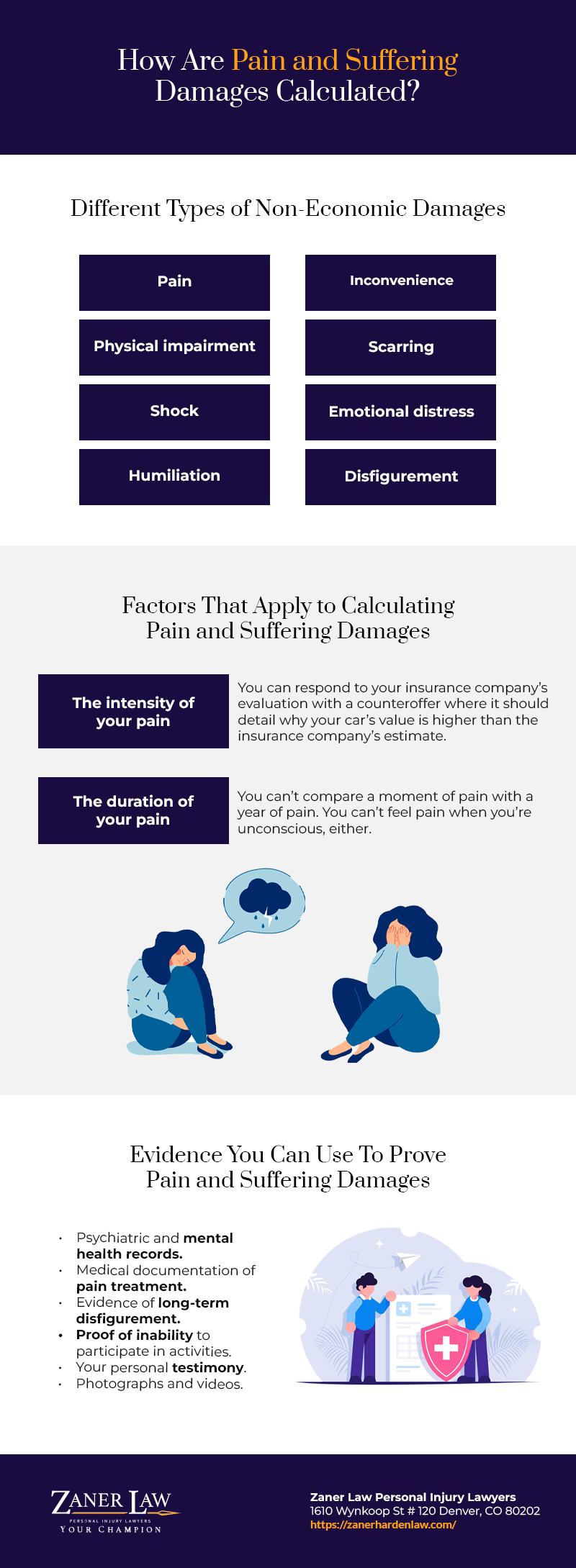How Are Pain and Suffering Damages Calculated?

Typically, you can receive two types of compensation for a personal injury claim: economic damages and non-economic damages. Once in a while, a court will award punitive damages. The difference between the two is simple. Economic damages are easy to count and include medical bills, for example, or lost earnings. Non-economic damages are difficult to calculate they include emotional distress, for example, or loss of enjoyment of life.
Pain and suffering damages are also a type of non-economic damages, although the two terms are sometimes used interchangeably. This article will fill you in on how they are calculated and how an attorney can help you recover full compensation for your claim.
Different Types of Non-Economic Damages

Examples of non-economic damages include, but may not be limited to, the following:
- ‘Pain’ refers to the physical discomfort you experience as a direct result of your injury. It might include other forms of physical discomfort, such as respiratory distress if you have difficulty breathing.
- ‘Inconvenience’ compensates you for difficulties in your daily life and routines.
- ‘Physical impairment’ refers to any lasting physical disability.
- ‘Scarring’ refers to permanent physical blemishes.
- ‘Shock’ refers to the initial acute emotional and psychological impact immediately following the injury.
- ‘Emotional distress’ refers to psychological suffering, such as shock and trauma.
- ‘Humiliation’ refers to embarrassment or loss of dignity.
- ‘Disfigurement’ refers to changes in physical appearance caused by your injury.
- ‘Depression’ refers to clinical depression or persistent feelings of sadness.
- ‘Anxiety’ refers to ongoing nervousness, worry, or fear as a direct psychological effect of the injury.
- ‘Loss of enjoyment of life’ refers to the Inability to engage in hobbies or activities you once enjoyed.
- ‘Loss of consortium’ or companionship refers to the loss of intimacy from your spouse or partner.
Colorado offers a different set of damages for wrongful death claims, some of which are non-economic damages (grief, for example).
Factors That Apply to Calculating Pain and Suffering Damages

When calculating the actual magnitude of a pain and suffering claim, the following factors come into play:
- The intensity of your pain: Some conditions are far more painful than others. Other conditions involve significant suffering that you might not classify as pain – confinement, for example.
- The duration of your pain: You can’t compare a moment of pain with a year of pain. You can’t feel pain when you’re unconscious, either.
- The ease with which doctors can diagnose your pain. Doctors might have a hard time proving whiplash, for example.
- The nature of your pain and the type of injury causing it. Different types of pain can affect your life in different ways. Traction, especially over long periods of time, can drive you crazy.
- Mental limitations arising from your pain. Inability to think about anything but your pain, for example.
Impact on your daily life. Can you still spend time outdoors? Can you walk around the block? Can you play fetch with your dog? - Diagnosable nervous conditions such as PTSD.
- Long-term consequences such as disfigurement or disability, even if not directly painful.
- The inability to continue sexual relations with your spouse.
Many other factors can come into play as well.
Evidence You Can Use To Prove Pain and Suffering Damages
Pain and suffering is a subjective experience that is not always easy to prove objectively. Following is a list of some of the evidence that you might use:
- Psychiatric and other mental health treatment records.
- Medical documentation of pain treatment.
- Evidence of long-term disfigurement.
- Expert testimony about your loss of a limb or a body part and its mental and physical effects on your life.
- Proof of your inability to participate in activities that you previously enjoyed, such as swimming or tennis.
- Your medical records.
- Your personal testimony. Including journal entries, about your pain, suffering, and the impact of your injuries on your daily life.
- Testimony from your family, friends, or colleagues about your suffering.
- Photographs and videos. By the way, stay off of social media while your claim is pending.
- Documentation showing missed work, reduced hours, or inability to perform your pre-accident job duties.
- Records from physical therapists about the extent of injuries and the progress of any rehabilitation efforts.
In settlement negotiations, the parties will probably settle for an amount that reflects the amount that they believe a court would award if the case went to trial.
Legal Limits on Pain and Suffering Damages
As of 2023, the legal maximum pain and suffering damages in Colorado amounted to $642,180.00. If you can prove a greater need for non-economic damages by “clear and convincing evidence,” you can qualify for up to double this amount. These amounts tend to rise slightly each year to account for increases in the cost of living.
Settlement Talks: The Standard Equations
It’s difficult for two negotiating parties to agree on a specific dollar figure for pain and suffering compensation without some sort of framework. There are two frameworks that most negotiators choose between to calculate them: the per diem method and the multiplier method.
The Per Diem Method
You can express the per diem method as:
DV X [number of days of suffering] = Pain and suffering compensation.
“DV” means the daily value of your suffering, which you will have to negotiate with the opposing party. Let’s say you agree on $300. The number of days of your suffering typically equals the total number of days that elapse between the date of the accident and the date that your doctor declares that you have reached maximum medical improvement (MMI).
Let’s suppose it’s 180 days. In that case, your pain and suffering compensation would equal $300 X 180 = $54,000. Add in your economic damages, plus any punitive damages you might receive, to arrive at your gross personal injury compensation.
The Multiplier Method
Using the multiplier method, you choose a multiplier with a value of between 1.5 and 5. As with the per diem method, you must negotiate this value with the opposing party. The value of your pain and suffering claim using the multiplier method is:
M X [your medical expenses] = pain and suffering compensation, where M is your multiplier. So if your multiplier is 3 and your medical expenses are $27,000, your pain and suffering compensation is 3 X $27,000 = $81,000.
You’ll Almost Certainly Need a Denver Personal Injury Lawyer for This One
The value of a pain and suffering claim often adds up to more than half of the total value of a personal injury claim. Negotiation and, if necessary, litigation, is tricky business when you’re asking for this much money. That’s why you’re probably going to need an experienced Denver personal injury lawyer to help you.
Pain and Suffering Infographic


